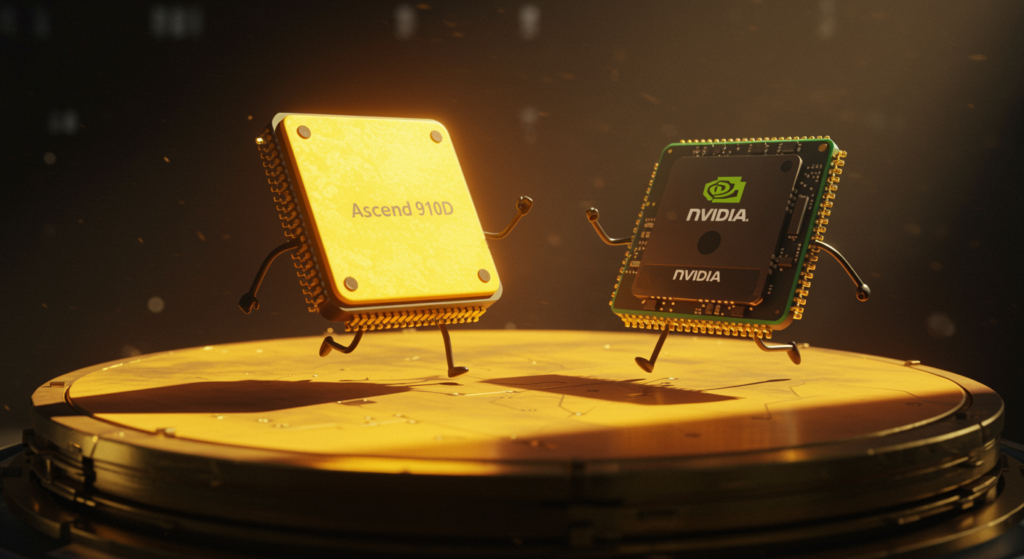
Nvidia Stock Drops Amid Huawei’s AI Chip Development Post-Ban
In a fast-paced tech world where innovation never sleeps, Nvidia’s stock took a hit on April 28, 2025, after news broke that Huawei is pushing forward with a powerful new AI chip. This Nvidia stock drop highlights the growing tensions in the US-China tech race, where export restrictions are reshaping the semiconductor landscape. As investors watch closely, it’s clear that Huawei’s moves could shake up the market for good.
Huawei’s Bold Challenge to Nvidia’s AI Lead
Huawei is stepping up its game by testing the Ascend 910D, a cutting-edge AI processor designed to rival Nvidia’s top offerings. This development comes as US export bans limit Chinese access to Nvidia’s advanced chips, forcing companies like Huawei to innovate independently. Nvidia stock drop events like this one show how quickly global rivalries can impact share prices.
Reports from The Wall Street Journal indicate that Huawei has reached out to Chinese firms to test the Ascend 910D’s capabilities, aiming to match or exceed Nvidia’s H100 model. With samples set to roll out by late May, this push aligns with China’s strategy for tech self-reliance in AI and semiconductors. Have you ever wondered how one company’s breakthrough could ripple through an entire industry?
Market Shake-Up from the Nvidia Stock Drop
The immediate fallout was stark: Nvidia shares plummeted nearly 4% on Monday, dragging down the Dow Jones and S&P 500. This Nvidia stock drop is part of a larger trend, with the company’s value dipping about 20% since the year began. It’s a reminder that in the volatile world of tech investments, news from competitors can hit hard and fast.
Back in January, Nvidia faced a massive $600 billion market cap loss after a Chinese startup’s AI announcement. Now, with Huawei in the mix, investors are bracing for more uncertainty. Nvidia chose not to comment on these developments, leaving analysts to speculate on the long-term effects.
Why the Nvidia Stock Drop Has Investors on Edge
Several factors are fueling worries for those holding Nvidia shares, from export curbs to emerging competition.
Export Restrictions’ Heavy Toll
US sanctions have blocked Nvidia from selling its most advanced AI chips to China, leading to a projected $5.5 billion charge in the first quarter. These rules, tightened under Biden’s administration, stem from fears that the tech could bolster China’s military capabilities. As a result, the Nvidia stock drop reflects broader geopolitical risks that investors can’t ignore.
It’s like watching a high-stakes game where one wrong move could cost billions—what strategies are companies using to navigate these bans?
Huawei’s Rising Influence in AI Chips
Huawei isn’t stopping at the Ascend 910D; it’s already shipping hundreds of thousands of its existing chips to giants like ByteDance. This scale suggests Huawei is building a real alternative to Nvidia, potentially capturing market share in the AI sector. For Nvidia, this could mean a shift away from its dominant position, accelerating the recent stock drop.
Imagine if your favorite tech tool suddenly had a strong rival—how would that change your choices? This competition is pushing the industry toward more diverse options.
Revenue Hits and Software Shifts
Nvidia’s revenue from China has plummeted from 26% in 2022 to just 13% in 2025, thanks to these restrictions. Analysts warn that Huawei’s progress might speed up this decline, especially if developers abandon Nvidia’s CUDA platform for Huawei’s alternatives. A quote from independent analyst Richard Windsor sums it up: “The real threat is China’s push to shift developers away from Nvidia’s ecosystem.”
This isn’t just about hardware; it’s about the full tech ecosystem. If you’re an investor, keeping an eye on these trends could help you spot opportunities before they fade.
China’s Drive for AI Independence
At the heart of Huawei’s efforts is China’s national goal to reduce reliance on Western tech. Premier Xi Jinping has stressed the need for mastery in high-end chips and AI software, calling for an “independent and controllable” system. This push has been supercharged by US export bans, turning challenges into catalysts for innovation.
Experts like Neil Shah from Counterpoint Research note that these restrictions are accelerating China’s AI chip ambitions. It’s a classic case of adversity breeding creativity, but how will this affect global players like Nvidia?
The Challenge of Scale in Semiconductors
In the chip industry, size matters—big time. High fixed costs mean that losing market share can cripple R&D investments, creating a vicious cycle. We’ve seen this with past players like Nortel, which lost ground to Chinese competition and never recovered.
For Nvidia, maintaining its edge requires steady sales to fund innovation. A sustained Nvidia stock drop could tip the scales, making it harder to stay ahead. As an investor, diversifying your portfolio might be a smart move to weather these storms.
Technical Showdown and Realistic Timelines
While Huawei aims for the Ascend 910D to outpace Nvidia’s older H100, Nvidia has already advanced to its Blackwell series. Analysts like Faisal Kawoosa suggest that true parity is still years away, with the Ascend 910D as a promising but unproven step. This gap could ease some pressure on the Nvidia stock drop in the short term.
Real-world testing will reveal more, but for now, it’s a waiting game. What if Huawei closes the gap faster than expected—could that reshape the AI market overnight?
Wider Market Dynamics at Play
This Nvidia stock drop isn’t happening in isolation; it’s part of a bigger picture with earnings reports from tech giants looming. The S&P 500 and Nasdaq felt the ripple, underscoring how interconnected the market is. Add in issues like the TikTok ban debate, and you see the US-China rivalry playing out everywhere.
These events remind us that tech investments often hinge on global politics. Staying informed can help you make better decisions in a fluctuating landscape.
Future Stakes in AI Chip Innovation
The Nvidia-Huawei face-off is more than business; it’s a geopolitical tug-of-war with AI at the center. As nations vie for tech supremacy, companies must adapt to a splintered world. For investors, this means thinking about diversification and long-term strategies.
Consider a hypothetical: If AI chips become regionally siloed, how would that affect global innovation? Here’s a tip—keep an eye on emerging markets and regulatory changes to stay ahead.
Wrapping Up the Nvidia Stock Drop Story
In the end, this Nvidia stock drop underscores the semiconductor industry’s volatility and the power of geopolitics. While Huawei’s Ascend 910D is a serious contender, the future will depend on tech advancements, ecosystem growth, and policy shifts. What are your thoughts on how this rivalry might evolve?
If you’re passionate about tech trends, I’d love to hear your insights in the comments below. Share this post with fellow investors or check out our related articles on AI innovations for more depth.
Sources
- Investopedia. “Nvidia Stock Drops on Report Huawei Is Developing Rival AI Chip.” Link
- Seeking Alpha. “Nvidia Leads Chip Stocks Lower Amid Huawei Challenge and Big Tech Earnings Week.” Link
- BAHA. “Nvidia Stock Falls 4% as Huawei Unveils New AI Chip.” Link
- Finger Lakes 1. “Nvidia vs. Huawei: AI Chips in April 2025.” Link
- Techzine. “Huawei Focuses on New AI Chip as Alternative to Nvidia.” Link
- ITIF. “China Is Rapidly Becoming a Leading Innovator in Advanced Industries.” Link
- Network World. “Huawei Steps Up AI Chip Race with Ascend 910D Targeting Nvidia’s High Ground.” Link
- GitHub. “ML News of the Week.” Link
Nvidia stock drop, Huawei AI chip, Ascend 910D, semiconductor competition, US-China tech rivalry, AI chip market, Nvidia shares tumble, export restrictions, tech innovation, market dynamics







